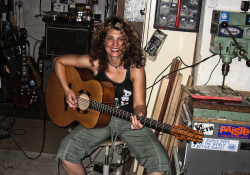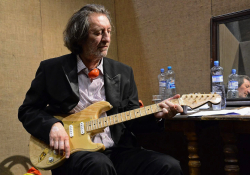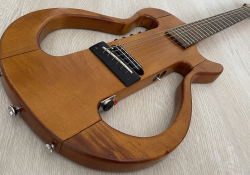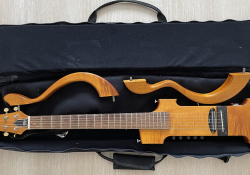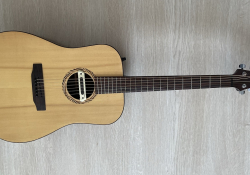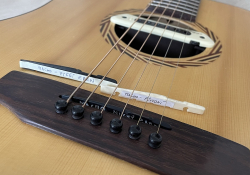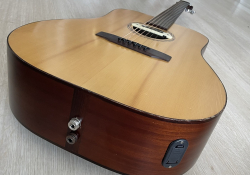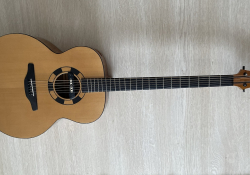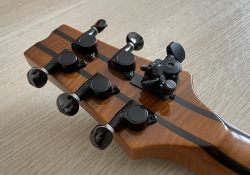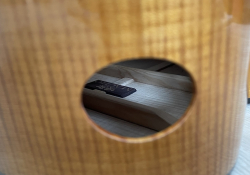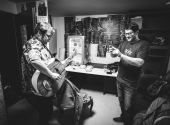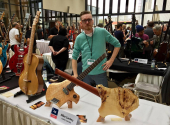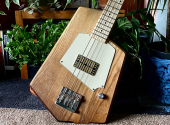
Dreamstruments #3: Macho Guitars
Hodslavice in the north of Moravia is not only the birthplace of the "father of the Czech nation" František Palacký but also the location where Zdeněk Macho, a long-standing figure in Czech guitar makers’ hall of fame, lives. His experience gained while making hundreds of guitars (not only) can be transformed into your “dreamstrument” at Macho guitars. Just like it happened to me, even several times.
In the first part of Dreamstruments series, I wrote about my recent acquisitions, but my journey to an extensive collection of unconventional custom instruments began more than 20 years ago right in Hodslavice. It reminded me of an interesting acoustic cover of the famous Ozzy Osbourne/Randy Rhoads duo. I was shocked to find out that "my" guitar was played in the music clip! How was that possible? I started my investigations, and the truth soon came out. It wasn't really my guitar, but my instrument served as an inspiration for this direct "descendant" owned by American guitarist Janet Robin.
Macho FBM travel
The unmistakable shape of this special folding travel guitar exists only in a few copies—and all of them were made by Zdeněk Macho. I was working in Russia at the time and needed a little more space-saving instrument for the plane. My inspiration then was Yamaha Silent Guitar but upgraded to a silent hybrid piece with dual pickups and electroacoustic sound to avoid disturbing neighbours in hotel rooms. Just to explain, FBM is my old nickname (Folk Blues Metal), which clearly expresses my wide-ranging sonic requirements. Mr Macho had previously made a quiet concert electric violin and cello for my former band SSOGE. Incidentally, this e-cello works perfectly well up to now in the meanwhile internationally successful ethno doom band. So it wasn't a complete "exploration of unknown territories by struggle" for once.
The contours of the body were originally designed from metal tubes covered with foam, similar to the historical Aria Sinsonido. (Un)fortunately, technological complications necessitated a change of plan, and the removable “wings” were finally shaped from the same wood as the centre neck-through block. This almost Hollywoodesque twist looked so great in the end that when the finished guitar was waiting for me in the workshop for a while, three more customers ordered the same piece (even though not the detachable one). And also the aforementioned Janet Robin, who was literally captivated by my baritone (see below) and wanted a similar instrument, just more space-saving. So, by combining my two original designs, the Macho "FBM/Robin" baritone travel was created, which, besides the incriminated Crazy Train clip, also appeared in the official presentation of the famous Seymour Duncan company.
As they sing in Moravian folk songs: maple wood, good for fiddles... So Macho FBM travel is made of maple varnished in a beautiful natural honey colour. The fretboard is made of wenge, and the bridge with strings through is ebony. The construction is actually quite simple yet visually very impressive. The removable wings affect not only the ergonomics but also the sound itself. With them, the guitar resonates even significantly more and is audible even unplugged (ideal for quiet night practice, for example). After a while, I improved its operability with knurled-head screws for hand tightening. These replaced the original, admittedly "invisible" worm screws, which required a small Allen wrench for (de)assembly—and I kept losing it. Due to the proximity of the mechanics on the tapered headstock, I couldn't use the Allen wrench holder, which Floyd Rose tremolo owners often attach to the back of the guitar head.
I wanted a hybrid sound, both acoustic and distorted electric, which was successful, as heard in the demos. So the guitar is equipped with a piezo pickup in the bridge, its own preamp and basic equalization. The piezo character is very different from, for example, the clean sound of magnetic pickups and much closer to the sound of an acoustic guitar. Appropriately added effects can serve sufficiently in live applications. Due to the size of the RM Rails, a non-humming rail humbucker in the shape of a single is used at the bridge. It originally had a splitter as well, but sonically it was too harsh, plus it got confused with the pickup switch, so I ended up removing this mini switch.
Hybrid tip: With this type of guitar, it's a good idea to think about what style you play. Usually, it doesn't have two magnetic pickups. If you want to play clean chords, jazz or melodic lines (remotely similar to a semihollow guitar), a neck pickup is OK. But if you are into (even slightly bluesy) overdriven riffs, you can't do without a bridge pickup. Not to mention the higain "chugga chugga" of course.
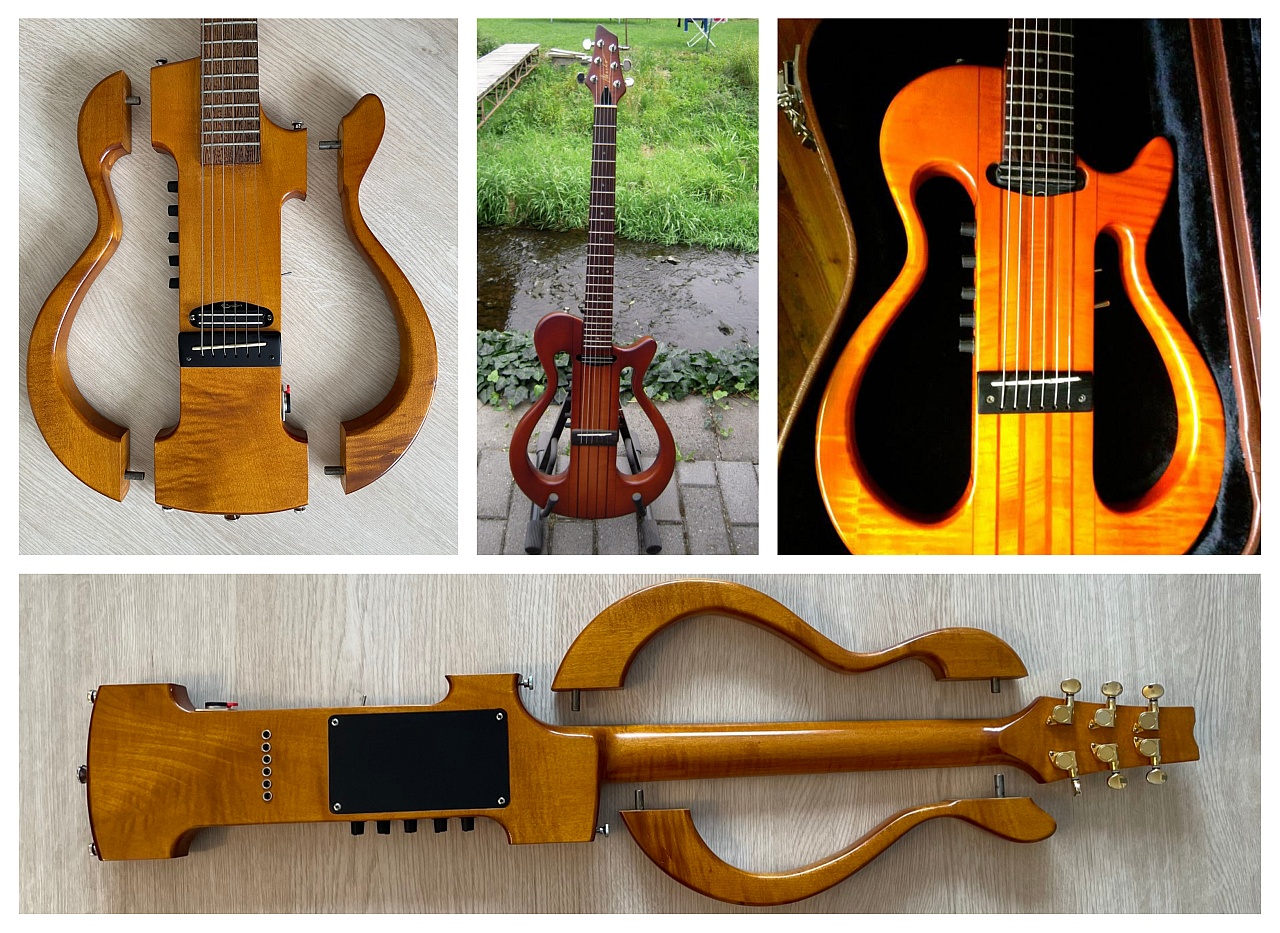
Archival commentaries have reported that the sound is similar to, or even better than, the Godin Multiac acoustic Yamaha APX. This was, of course, a bit of an exaggeration, but the Macho FBM travel served me faithfully in the wild acoustic crossover Symfonická Dáseň, as well as when travelling. I only had to "lightly" tweak (or completely remake) the custom gigbag, the exact specifications of which, as a trained manager, I certainly didn't underestimate. Personally, I went a long way with the instrument to accurately show, explain and then write down and photo-document the successful progress of the unconventional work. And still they screwed it up. :( Sometimes even a lot is not enough. Fortunately, the prestigious American magazine Premier Guitar lifted my spirits when they found this unconventional instrument from the Czech Republic so interesting that it appeared in their gallery of unique instruments under #27.
But as I mentioned, it's not my only guitar by Macho guitars. The real explosions of creativity happened with the two acoustic guitars.
Macho FBM acoustic
As a once young, up-and-coming, yet totally style-obsessed folk-blues-metal player, I needed an acoustic guitar with a sound very different from what is considered a nice acoustic sound. In fact, I had spent literally hundreds of hours searching for the right acoustic sound for a complex mix with stepped-up rhythms—a good sounding "acoustic metal". And I really didn't choose a very easy discipline. Even in the world there were only a few examples of this. To illustrate, I'll choose the parodically burlesque but sonically great Tenacious D or our local provenience – the album Ondráš by Tomáš Kočko. Unfortunately, his strange ovation, which I had the opportunity to strum a few times, was stolen from his van. And after that, he was only getting closer to this exceptionally full guitar sound. From careful listening and thorough analyses of the available examples, it was clear that (very simplistically) the complete basis is the guitar itself, and at the same time it cannot be a conventional instrument. It has to have strong mids, less bass/treble, and a kind of dry, seemingly uninteresting sound that blends well with the other instruments. Of course it's much more complicated in terms of overall arrangement or frequency non-interference, but that's enough for an initial explanation. In addition, I am still extremely annoyed by the various odd sounds, rattles and drowning out of the guitar when playing dynamically. So finding a dreamstrument like this in a Czech shop 20 years ago was pure utopia.
As I was commuting to work through Hodslavice at that time, I used to stop by Zdeněk Macho's place to discuss my ideas, requirements, materials and construction until it crystallized into a special guitar called, in Wallachian dialect, Středovica. Since then it has shown its studio power many times. In the discipline of complex mixing, it beat even high-end and expensive instruments hollow, which in comparison sounded as if they had been turned down a few dB. It made the most of its strengths, for example, in the following "eclectic atheistic samba", where it doesn't lose even in the thunderingly avant-garde company of prog bass, aggressively dissonant keys and brutal double-kick drum salvos.
The album Forgotten Silence thus became another unexpected refuge for this strange guitar, which incidentally was rated by orthodox gypsy jazzman Jaco EkBalam as the only dreadnought he enjoyed playing. And I can understand that, because the mids are really so distinctive (and gypsy guitar-like) that it's literally beyond belief :) For example, I do some solo preludes on other guitars because the one and only place for “Středovica” is in more complex mixes.
I always laugh when someone looks inside and wonders how oversized it is, with a thicker soundboard and aggressive sound. But that's its biggest strength, therefore it can take such heavy hits without annoying rattling and buzzing, and I use two bridge saddles of two different heights as needed. When I record accompaniments, I prefer to have a higher action and thicker strings, which is not very comfortable for doing solo, so I adjust according to the situation. Material-wise, we ended up with classic resonant spruce and mahogany, and we were more concerned with the thickness of the various structural elements.
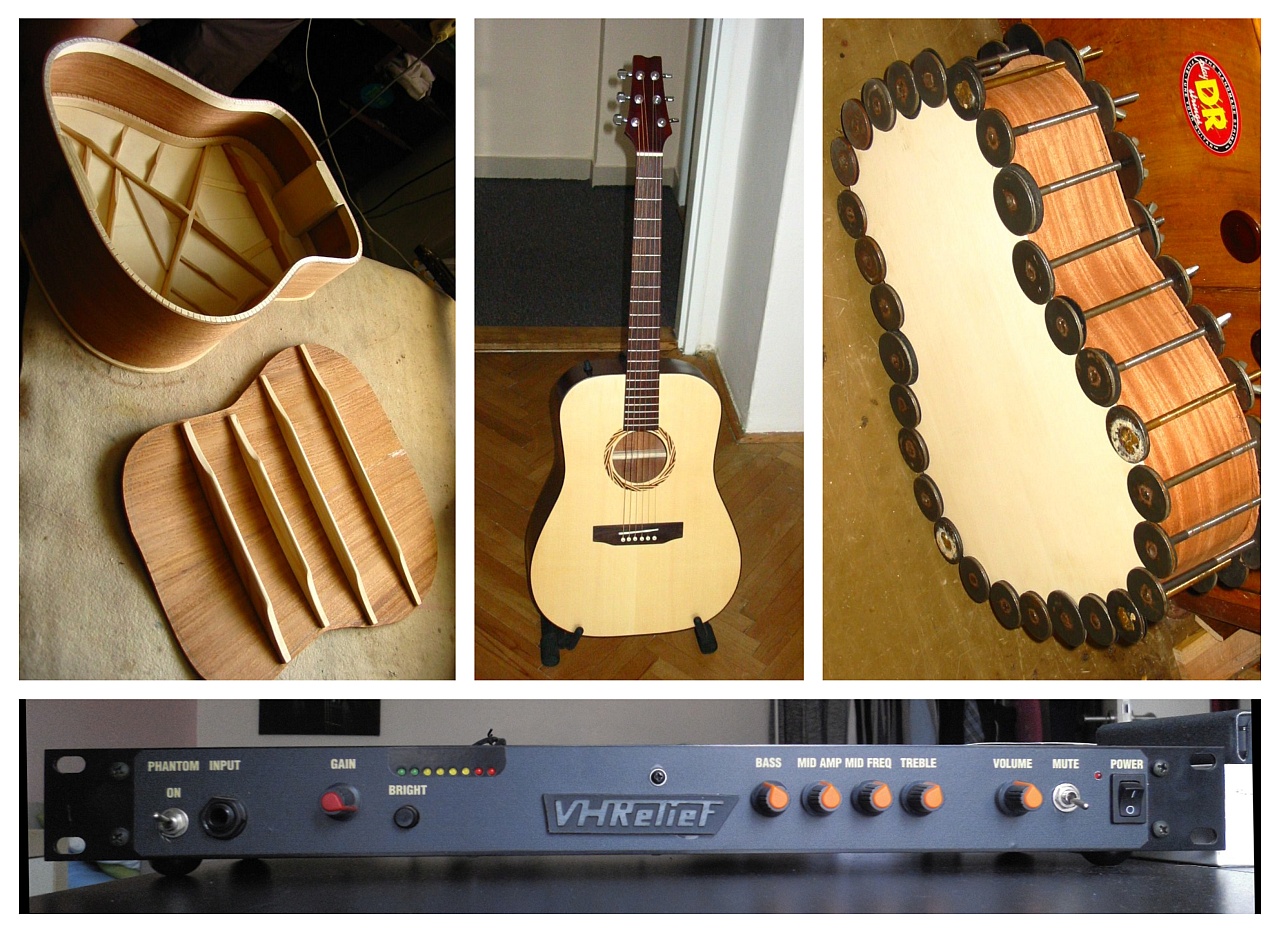
Under the influence of the "online chat experts" we also tried the experiment of not disrupting the sides with any holes and not burdening them with any pickups, so I had a special VHRelief preamp with phantom power to the piezo pickups over the cable. Back then, I, the foolish dreamer, still thought that this preamp and a rack compressor would be enough. Then practice proved that it was actually annoyingly non-standard nonsense and I had a small battery powered preamp fitted with at least a volume control. On stage, you'll welcome the option to instantly mute the instrument getting acoustic feedback, and from experience I recommend having this sorted out (use a stompbox of some sort either on your hand or on your foot).
Likewise, the battery case in the side is infinitely more convenient than removing the strings and getting inside the instrument. Especially in the middle of a gig, it can turn into a very humiliating display of ineptitude. So as not to offend any collectors or internet wisdom peddlers—after all, you don't play regular concerts on such rare instruments that would be "hurt" by such irreversible actions! So it's misleading to tell to performing musicians that any change would spoil the sound or even ruin the guitar.
If you want to play in public, you have to capture the sound somehow. Over time, in my search for a sound, I came up with a combination of pickups, so I added an L.R.Baggs M80 magnetic pickup to the soundhole, which nicely complements the B-Band piezo spectrum, especially on thin strings, where it helps eliminate the annoying piezo ping & quack. But literally the biggest challenge was yet to come.
Macho FBM baritone
After a couple of years of metal lower tuning, I started to wonder if such possibilities exist for acoustics. Deep sounds are very pleasant to the human ear, and there is a good reason why the vast majority of commercials or movie trailers are spoken in a deep male voice. Occasionally, I've come across snippets of information about so-called baritone guitars (with an extended scale length), American guitar makers and a few companies offered some instruments. There were even D'Addario strings for the acoustic baritone, and one video literally touched the right chord. I longed for such a guitar but asking for it in our shops was completely useless.
So we put the preparatory R&D round again, tried to find out what we could and started planning slowly. From the discussions we came up with the biggest possible body to carry the massive bass, the material besides the obligatory spruce for the rest of the body was a brighter flame maple to avoid booming of the guitar, but what scale length? Nowadays, it's easy to Google it, but at the time, actually, the only information we had available was the data from the box of the aforementioned EXP23 strings. There, it states that the string tension was measured at a scale length of 29.75", which is more than 10 cm longer than usual. So we had some info to start with, and then it was more or less classic work in enlarged dimensions. The result is a huge baritone with a piano tone that mostly makes everyone "go crazy". Quite apt for my tree ambient project.
It was quite a big risk, but it worked out great. I didn't notice anyone having a similar instrument in our country at that time. So I dare to call it the first Czech acoustic baritone guitar (no guarantee). Today, I know that, for example, the scale length didn't have to be that extreme (although Danelectro uses 30" on their electric baritones). Thanks to the considerably higher string tension (up to 40% higher than normal acoustics), I have it tuned A1 – A3 by default and in some songs I tune it up to G and it still holds up just fine. But some chord strumming isn't just the job, it makes it best in breakdowns and various slow arpeggios that temptingly stir the deepest recesses. As it impressed Randy Rhoads' student Janet Robin, who was literally thrilled with it and immediately ordered a similar guitar.
Because it's really huge and the listening experience for the guitarist is a bit shifted, I've tuned it up a bit over time. Eventually, even with two soundports, which not only serve as a personal monitor, but also, according to my recent depth surveys, support the projection of just the bass.

Picking up sound is a bit tricky, because the typical piezo in such a tuning unfortunately highlights its shortcomings. Which is well known to owners of acoustic bass guitars, where piezo pickups provide a smacking sound at the limit of usability. And I chose Shadow Nanoflex, which was supposed to counteract these undesirable effects with a special material. Still, it's not great. But because I believe in the power of combo pickups, I did some in-depth analysis of suitable magnetic pickups, and finally chose the L.R. Baggs M1. It was annoyingly metallic in a normal guitar, but it adds the desired concreteness to the baritone. Incidentally, I always add a pickup to my microphones in the studio because that's the way the resulting sound is the fullest.
I also have a Sperzel D-Thing installed on the head, the only functional retune for such a thick string, which also required a bit of communication and engineering, just because of the thickness and depth of the string. Of course, tuning and re-tuning is a welcome deepening of the creative palette here, just be careful and check everything on a string tension calculator first. So that the strings don't either sag or crack. In the end, this boldly experimental baritone caught the attention of the American Premier Guitar magazine and appeared in their acoustic guitar gallery under #16.
Zdeněk Macho somewhat neglects promotion and social networks because he says with exaggeration that he has enough orders until retirement. In the future, he is going to focus only on his guitar models which offer something different from the usual factory production. So if your wishes and requirements intersect, you can also try to make your dreams come true with him.
If you have found an error or typo in the article, please let us know by e-mail info@insounder.org.

